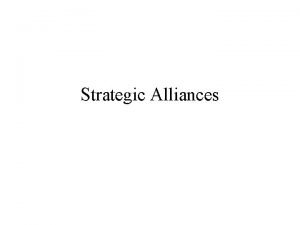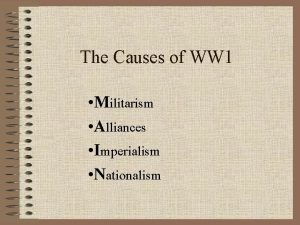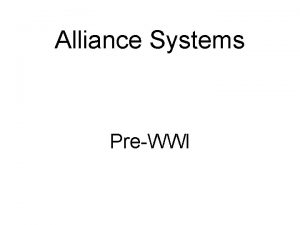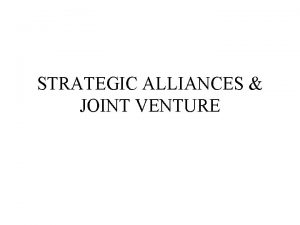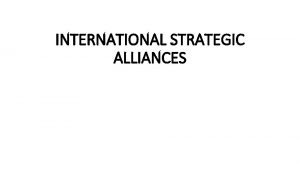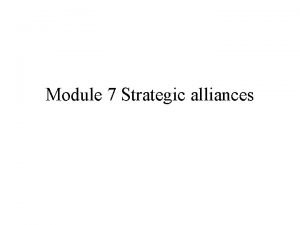Chapter 7 International Strategic Alliances Introduction What is





















- Slides: 21

Chapter 7 International Strategic Alliances

Introduction • • • What is meant by Strategic Alliance? Purposes of Strategic Alliances Success Factors Mistakes Leading to Failure Types of Alliances Examples

Introduction • A firm wishing to enter a new market often faces major difficulties, such as deep-rooted competition or tough government regulations. Partnering with a local firm can often help it exceed such barriers. • A firm may want to learn more about: • how to produce something, • how to acquire certain resources, • how to deal with local governments' regulations, • And how to manage in a different environment— information that a partner often can offer.

Introduction • Failure rate of International Strategic Alliances is 30% to 60%. • Even profitable alliances can be uncertain by conflict. • strategic alliances are very risky and unstable.

What is Strategic Alliance? Definition of Strategic Alliance : § A strategic alliance is an agreement between two or more parties stating that the involved parties will act in a certain way in order to achieve a common goal. § Partners may provide the strategic alliance with: § Resources such as products, § Distribution channels, § Manufacturing capability, § and knowledge, expertise.

What is Strategic Alliance? • The alliance is a cooperation which aims for a interaction where each partner hopes that the benefits from the alliance will be greater than those from individual efforts. • Strategic alliance usually make sense when the parties involved have Complementary strengths.

Why Strategic Alliance? • • • Adding value to products/services. Improving market access. Strengthening operations. Adding technological strength. Enhancing strategic growth. Building financial strength.

Figure. 1 : Benefits of Strategic Alliances Potential Benefits of Strategic Alliances Ease of Market Entry Shared Risk Shared Knowledge and Expertise Competitive Advantage

Benefits of Strategic Alliances • A strategic alliance may allow the firm to achieve the benefits of fast market entry while keeping costs down. • Enabling a firm to focus resources on its core skills & competencies while acquiring other components or capabilities it lacks from the partners. • Enable partner firms to combine their individual strengths & work together to reduce non-value-adding activities which lead to improved performance. • Improve market power of a firm because the distribution channels & buying power of the partners can be combined.

Success Factors • 1. Selection: – Selecting strategic partner should be based on company’s goals, objectives & values system. – Select partners who have capabilities in collaboration and ability to work in a collaborative environment. • 2. Trust: – Existence of trust in a relationship reduces the risks associated with opportunistic behavior as this generates greater profits and serve customers better.

Success Factors cont’d • 3. Communication: – Communication is critical for building successful relationships to achieve the benefits of collaboration as it allows partners to understand alliance goals, responsibilities and helps with the sharing of individual experiences • 4. Conflict Resolution: – Firms should be motivated to engage in joint problem solving as they are, by definition, linked together to manage an environment that was more uncertain and unsettled.

Success Factors cont’d • 5. Developing a focused winning strategy : – Based on distinctive competencies and competitive advantages of the partners in the selected target market (s). – To ensure there will not be a conflict between alliance partners. – To be able to manage the company cultural challenges that may arise between the alliance partners.

Success Factors cont’d • 6. Define and align decision rights: – To define what decisions are important to the alliance, which partner should make them and how the decisions will be made and monitored. • 7. Exit Strategy: – Agree upon an exit strategy for the alliance. It Is important to have agreement in advance on how the alliance will be concluded if and when it may fail and/or when it has achieved its objectives.

Mistakes Leading to Failure • One of the partners is too dependent on the other’s capabilities. • Problems and dilemmas of mistrust. • Cultural and language barriers. • Limited access to the information, for a collaboration to work effectively, one partner (or both) may have to provide the other with information it would prefer to keep secret.

Types of Strategic Alliances • Equity strategic alliance: an alliance in which two or more firms own different percentages of the company they have formed by combining some of their resources and capabilities to create a competitive advantage. • Non- equity strategic alliance: an alliance in which two or more firms develop a contractualrelationship to share some of their unique resources and capabilities to create a competitive advantage.

Types of Strategic Alliances cont’d • Joint Venture: • A joint venture (JV) is a special type of strategic alliance in which two or more firms join together to create a new business entity that is legally separate and different from its parents. • Each of the businesses has an equity stake in the individual business and share revenues, expenses and profits. • Although unequal ownership is common, many are owned equally by the founding firms.

Types of Strategic Alliances cont’d • Franchising: • Franchisees pay a set-up fee and agree to ongoing payments so the process is financially risk-free for the company. • However, problems do exist, particularly with the loss of control over how franchisees run their franchise.

Types of Strategic Alliances cont’d • Marketing alliance: • is a functional alliance in which two or more firms share marketing services or expertise. • In most cases, one partner introduces its products or services into a market in which the other partner already has a attendance. • The established firm helps the newcomer by promoting, advertising, and/or distributing its products or services. • The established firm may negotiate a fixed price for its assistance or may share in a percentage of the newcomer's sales or profits.

Types of Strategic Alliances cont’d • Research and development (R&D) alliance: • R&D alliances tend to fall into the joint venture category, where two or more businesses decide to started a research venture through forming a new entity. • Distribution Relationships: • This is perhaps the most common form of alliance. Strategic alliances are usually formed because the businesses involved want more customers. The result is that cross-promotion agreements are established.

Examples • Starbucks partnered with Barnes and Nobles bookstores in 1993 to provide in-house coffee shops, benefiting both retailers. • A Starbucks-United Airlines alliance has resulted in their coffee being offered on flights with the Starbucks logo on the cups and a partnership with Kraft foods has resulted in Starbucks coffee being marketed in grocery stores

Examples • Apple has partnered with Sony, Motorola, Phillips, and AT&T in the past. • Delta And Virgin Atlantic To Form Strategic Alliance. • Toyota's alliances with BMW
 Entry strategy and strategic alliances
Entry strategy and strategic alliances Global strategic alliance definition
Global strategic alliance definition Equity strategic alliance example
Equity strategic alliance example Entry strategy and strategic alliances
Entry strategy and strategic alliances Entry strategy and strategic alliances
Entry strategy and strategic alliances Alliances wwi definition
Alliances wwi definition Triple entente countries in world war 1
Triple entente countries in world war 1 Types of functional alliances
Types of functional alliances Doctrines et alliances
Doctrines et alliances The main cause of ww1
The main cause of ww1 Three world order
Three world order Angeliki dedopoulou
Angeliki dedopoulou Sap university alliances
Sap university alliances Ww1 alliances cartoon
Ww1 alliances cartoon Imperialism nationalism militarism alliances
Imperialism nationalism militarism alliances Alliances and acquisitions
Alliances and acquisitions Alliance of three emperors 1881
Alliance of three emperors 1881 Strategic fit vs strategic intent
Strategic fit vs strategic intent Strategic complements and substitutes examples
Strategic complements and substitutes examples Io model strategic management
Io model strategic management Tows matrix
Tows matrix Global marketing organization
Global marketing organization

